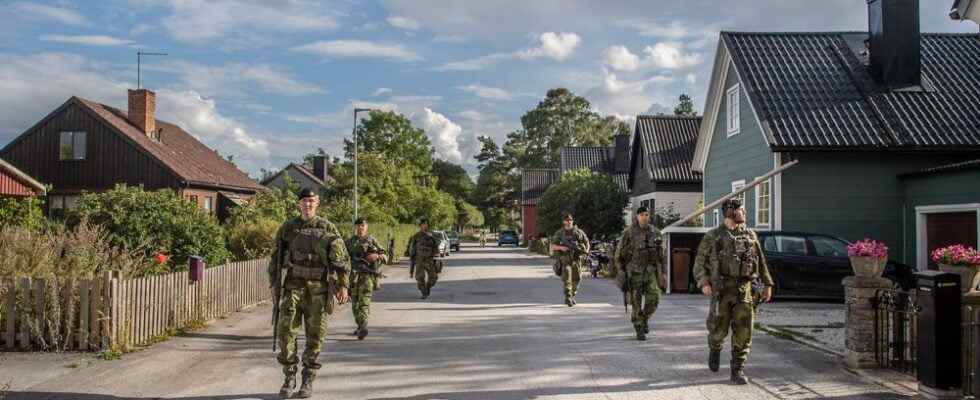Let’s fight in Northern Europe! The alert level suddenly went up a notch in Sweden last week, when the Russian naval presence in the Baltic Sea was suddenly increased from three to six warships – manned and armored landing ships. And this, at the very time when Moscow was conducting talks with the United States and with NATO, in Geneva and Brussels. Simultaneously, several large drones were detected above the country’s three nuclear power plants but also above Stockholm and the royal residence in the suburbs.
The overflights took place three evenings in a row under cloudy skies. The nationality of the aircraft is unknown but the Scandinavians have their own idea… Finally, at the same time, thousands of teenagers were receiving stories TikTok on their phones that evoked the scenario of an imminent Russian invasion. Armed movements, intimidation, rumours: three elements of a hybrid and psychological war brought together at the same time and in the same country, a member of the European Union.
Tuesday, January 19, the Chief of Defense Staff Micael Bydén intervened on television to reassure the population, surprised by the increase in the military presence in the streets and to explain why the Swedish island of Gotland, strategically located, was suddenly on a war footing, with the dispatch of reinforcements in equipment and men.
The visibility of the Swedish army on the streets has increased over the past week.
Regeringen.se
“Things are moving very quickly at the moment in Sweden and also in Finland”, explains Niklas Granholm, a fine connoisseur of security issues in Northern Europe, who explains why the evolution of the situation in Ukraine also concerns this region. If a conflict occurs in this country, the repercussions will affect Europe, starting with the countries around the Baltic”, underlines this expert from FOI, the Swedish Defense Research Institute. In fact, the Ukrainian border does not is only 400 kilometers from the Baltic Sea, and the border between Russia and the European Union is near St. Petersburg.
“We must ask ourselves about the fate of the Baltic republics”
“If Russia has bellicose intentions in Ukraine, then we have to wonder about the fate of the Baltic republics, knowing that Putin considers the dismantling of the USSR as ‘the greatest catastrophe of the 20th century'”, observes the general Swedish retired Karlis Neretnieks.
Swedish Defense Minister Peter Hultqvist (left) and Chief of Defense Staff Micael Bydén (seated).
Regeringen.se
In the scenario of an occupation of Estonia, Latvia or Lithuania, the control of Gotland becomes a crucial issue. “Because whoever controls the island can indeed interdict the airspace above the entire Baltic space with a single missile battery”, explains, in Stockholm, the expert Tomas Ries, of the School of War Forsvarhögskolan. It is therefore imperative to prevent Russia from seizing this island by a lightning landing.”
Curiously, the Swedes have Ukraine constantly in mind – and not only because the principality of Kiev was founded in the 9th century by Vikings, nor because King Carl XII was defeated there in 1709 by the army of Peter the Great in the decisive Battle of Poltava, which caused Sweden to lose its status as a European power. Closer to home, it was the annexation of Crimea by Russia in 2014 which decided Sweden to strengthen its military arsenal, almost completely dismantled after the fall of the USSR. After a first reinforcement of its budget in 2015, Stockholm decided in 2020 to increase it again and spectacularly by 50% over five years. By 2025, its defense budget will be equivalent to 1.6% of GDP.
“Refueling” of a helicopter on board the Johan de Witt of the Royal Netherlands Navy (file photo).
Regeringen.se
“Unlike the Swedes, the Finns did not commit the imprudence of demobilizing their army in the 1990s, continues expert Tomas Ries. And for good reason! They know their neighbors better than anyone. After being under Swedish domination, they lived under the Russian yoke from 1809 to 1917. They also heroically fought the Soviets twice: during the Winter War (1939-1940) and during the Continuation War (1941-1944). Finally, they have ” cohabited” with the USSR throughout the Cold War, following the doctrine which emphasized the need to maintain relations of trust with the Soviet Union.”
Last January 1, during his New Year’s speech, Finnish President Sauli Niinistö was the first to forcefully reject Vladimir Putin’s “unacceptable” ultimatum which, among other demands, demands that neither Finland nor Sweden not join NATO in the future. Swedish Prime Minister Magdalena Andersson also brushed off this request.
“Sleeping for a while, the debate on our membership in NATO [NDLR : à laquelle s’opposent les sociaux-démocrates et les écologistes] is now relaunched, says Swedish General Karlis Neretnieks.” And he suggests: “By dint of being threatening, Moscow will end up pushing Sweden into NATO…” In the meantime, the Russian flotilla has left the Baltic And Sweden continue to strengthen their defense.
